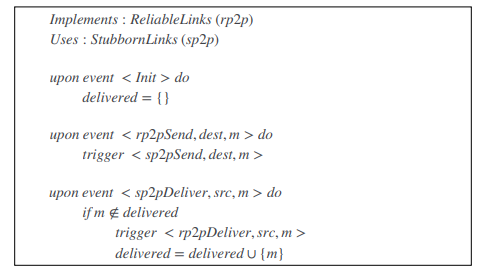9: Reliable Links and Failure Detectors
1/22
There's no tags or description
Looks like no tags are added yet.
Name | Mastery | Learn | Test | Matching | Spaced |
|---|
No study sessions yet.
23 Terms
Channel Assumptions
Messages should be transported between channels, from source to destination
Real channels are unreliable
Fair loss is usually a realistic assumption on channels
Fair Loss
A combination of assumptions that we make about the properties of communication links to provide an accurate modelling mechanism.
Fair Loss Link
Reflects the possibility for explicit retransmission.
Stubborn Link
A link that delivers a message infinitely often.

Fair Loss - Properties
If a message m is sent infinitely often by pi to pj and neither pi or pj crash, then m is delivered infinitely often to pj
Finite duplication
No creation
Finite Duplication
If m is sent finitely often by pi to pj then m is delivered a finite number of times to pj.
No creation
No message is delivered unless it was sent.
Stubborn Link - Properties
Stubborn delivery
No creation
Stubborn Delivery
If a process pi sends a message m to a correct process pj and pi does not crash, then pj takes delivery of m an infinite number of times.
Reliable Links (Perfect Links)
Links that make sure a message is successfully sent once.

Reliable Links - Properties
Validity
If pi and pj are correct, then every message sent by pi to pj is eventually delivered to pj
No duplication
No creation
Timing Assumptions
Processing speeds of processes (process asynchrony)
Transmission speeds of messages (channel asynchrony)
Types of System Model
Synchronous
Partially Synchronous
Asynchronous
Synchronous System Model - Properties
Processing - the time it takes for a process to execute a step is bound and known.
Delays - there is a known upper bound on the time it takes for a message to be received.
Clocks - the drift between local clock and global real time clock is bounded and known.
Partially Synchronous System Model - Properties
Timing bounds eventually hold, but you never know when
Asynchronous System Model - Properties
No assumptions - challenging to design for
While one process takes one step, any other process can take any unbounded (but still finite) number of steps
Failure Detector
An abstraction that allows us to encapsulate timing assumptions for distributed systems, providing processes suspicions about crashed processes.
Failure Detector - Example
Timeouts - uses timing assumptions and failure detection.
Perfect Failure Detector - Properties
Strong completeness
Strong accuracy
Strong completeness
Eventually every process that crashes is permanently suspected by every correct process.
Strong Accuracy
No process is deteced by any process before it crashes.
Eventually Perfecy Failure Detector - Properties
Strong completeness
Eventually strong accuracy
Failure Detector - Algorithm
Processes periodically exchange heartbeat messages
A process sets a timeout based on the worst case round trip of a message exchange
A process suspects another process if a timeout expires relating to that process
A process that delivers a message
